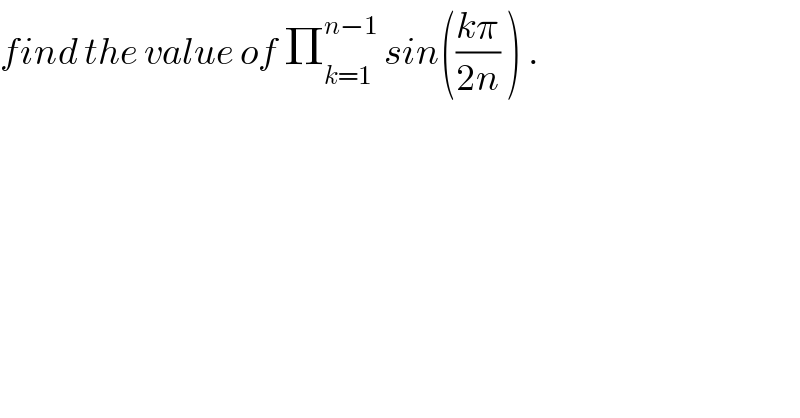
Question and Answers Forum
Question Number 27153 by abdo imad last updated on 02/Jan/18

Commented by abdo imad last updated on 03/Jan/18
![let introduce the polynomial p(x)= x^(2n) −1 the roots of p(x) are the complex z_(k ) =e^(i((2k)/n)) and k∈[[0,2n−1]] and p(x)=λ Π_(k=0) ^(n−1) (x−z_k ) its clear that λ=1 and p(x)=Π_(k=0) ^(n−1) (x−z_k ) we have z_0 = 1 , z_1 = e^(i(π/n)) , z_2 = e^(i((2π)/n)) z_(n−1) = e^(i(((n−1)π)/n)) , z_n = −1 , z_(n+1) = e^(i(((n+1)π)/n)) , z_(2n−1) =e^(i(((2n−1)π)/(2n))) we see that z_(2n−1) =z_1 ^− , z_(2n−2) =z_2 ^− , z_(n+1) =z_(n−1) ^− ⇒ p(x)= (x^2 −1) Π_(k=1) ^(n−1) (x −z_k )(x−z_k ^− ) =(x^2 −1) Π_(k=1) ^(n−1) (x^2 −2cos(((kπ)/n))x +1) and for x^2 ≠1 ((p(x))/(x^2 −1)) = Π_(k=1) ^(n−1) ( x^2 −2cos(((kπ)/n))x +1) and by using hospital theoem lim_(x−>1) Π_(k=1) ^(n−1) ( x^2 −2cos(((kπ)/n))x +1) =lim_(x−>1) ((p^′ (x))/(2x)) Π_(k=1) ^(n−1) 2(1−cos(((kπ)/n)))= lim_(x−>1) ((2nx^(2n−1) )/(2x)) =n ⇒ 4^(n−1) Π_(k=1) ^(k=n−1) sin^2 (((kπ)/(2n)) )=n ⇒ Π_(k=1) ^(n−1) sin^2 (((kπ)/(2n)) ) = (n/4^(n−1) ) ⇒ Π_(k=1) ^(n−1) sin (((kπ)/(2n)) )= ((√n)/2^(n−1) ) ( n≥2)](Q27214.png)
Commented by Tinkutara last updated on 03/Jan/18
I have already asked this a long time back. See this at Q 19292.
